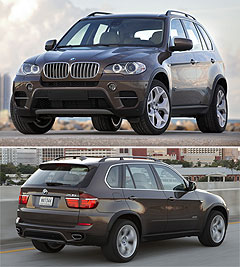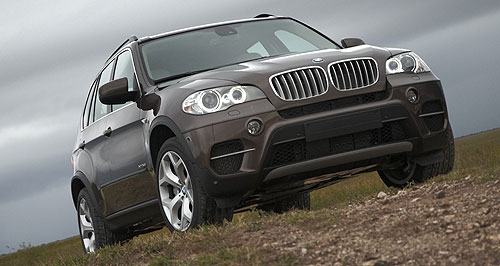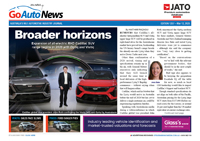Future models - BMW - X5First look: BMW readies X5 for Porsche, VW onslaughtX-fighter: Upgraded X5, due here in June, brings more performance, economy and options, plus new variant names and an eight-speed auto. Facelifted BMW X5 emerges ahead of renewed attack from new Cayenne and Touareg8 Feb 2010 BMW has given Australia’s top-selling luxury SUV a thorough pull-through in the face of fresh opposition from Porsche’s MkII Cayenne and Volkswagen’s new Touareg, both of which will appear for the first time in three weeks at the Geneva motor show. Revealed on the eve of the launch of its redesigned 5 Series sedan in Europe and due on sale here in June, the midlife makeover for BMW’s first and largest crossover wagon is headlined by more powerful and efficient engines matched with eight-speed automatic transmissions, plus brake energy regeneration across the range. While the entry-level X5 xDrive30i has been discontinued in the lead-up to the release of a more upmarket MkII X3 in Europe in October, there are new X5 variant names to reflect the significant powertrain upgrade, accompanied by subtle new exterior and interior cosmetics, upgraded electric power steering and more high-tech options. Exterior changes are limited to a new front bumper with larger air intakes, a deeper rear bumper and revised headlights and tail-lights, while inside the X5 gains new trim, the latest iDrive system and the new options of Active Cruise Control with Stop & Go function, Lane Departure Warning and Side View. But the biggest news is in the engine bay, where BMW has made substantial improvements in both performance and economy, thanks partly to the standard fitment of the new eight-speed torque converter automatic that debuted last year in BMW’s flagship 760Li limousine.  Gone is the 200kW/315Nm 3.0-litre straight petrol six of the base X5 xDrive30i, replaced by BMW’s 225kW/400Nm twin-turbo direct-injection six, upping power by 25kW and torque by 85Nm, and lifting claimed 0-100km/h by 1.3 seconds to 6.8 seconds. Gone is the 200kW/315Nm 3.0-litre straight petrol six of the base X5 xDrive30i, replaced by BMW’s 225kW/400Nm twin-turbo direct-injection six, upping power by 25kW and torque by 85Nm, and lifting claimed 0-100km/h by 1.3 seconds to 6.8 seconds.At the same time, the new X5 xDrive35i, fitted with an eight-speed auto, is said to be 1.6 litres per 100km more fuel-efficient, with average fuel consumption dropping to 10.1L/100km (versus 11.7L/100km for the outgoing xDrive30i). Also blessed with BMW TwinPower Turbo technology is the other petrol engine fitted to the new xDrive50i variant, which replaces the xDrive48i and brings the top-shelf non-M-badged X5 into line with BMW’s X6 SUV range. As in the X6 xDrive50i, its 4.4-litre twin-turbo V8 produces 300kW and no less than 600Nm between 1750 and 4500rpm - up 39kW and a massive 245Nm over the naturally aspirated 4.8-litre V8 in the X5 xDrive48i. Driving through eight rather than six transmission ratios, it is 1.1 seconds quicker to 100km/h than before (5.5 versus 6.6 seconds). Unlike the rest of the 2010 X5 range, however, the X5 5.0i is less efficient than the model it replaces, returning similar average fuel consumption but increasing average CO2 emissions by six grams per kilometre. Both diesel versions of the freshened X5 offer more power, torque and fuel efficiency. Average fuel economy for the volume-selling X5 xDrive30d has been reduced by 15 per cent or 1.3L/100km, from 8.7 to 7.4L/100km – despite an increase in power from 160 to 180kW and a corresponding half-second reduction in 0-100km/h acceleration, from 8.1 to 7.6 seconds. Finally, the third X5 variant to receive a new nameplate is the X5 xDrive40d, which replaces the xDrive35d and continues to be powered by an all-aluminium 3.0-litre straight-six common-rail diesel engine. This time, however, it offers 225kW (up 15kW) and 600Nm (up 20Nm), and accelerates to 100km/h in 6.6 seconds (down from seven seconds), yet returns 15 per cent lower fuel consumption – 7.5 versus 8.8L/100km. BMW says the addition of its speed-dependent Servotronic steering assistance system improves the X5’s parking manoeuvrability and steering effort at low speeds. Active steering and third-row seating options continue to be available. In an unusual move, BMW Australia has confirmed that pricing of the latest X5 will increase in line with its improved specifications and standard equipment levels when the newer model is launched here mid-year. Currently, the xDrive30i opens the X5 range at $86,635. The X5 has been Australia’s most popular luxury SUV for the past seven years. Launched here in November 2000, the original five-seat-only model was replaced in April 2007 by the larger second-generation X5, which last year attracted 3124 sales (down 8.3 per cent) for a dominant 15.6 per cent segment share. Sales in January were a massive 62.5 per cent up, with 286 sold – easily out-pacing Audi’s Q5 (242) and direct rivals like the Mercedes-Benz M-class (171), Lexus RX (165) and Audi Q7 (140). The range-topping X5 xDrive M super-SUV ($172,900) and a new Innovations options package joined the current X5 line-up in Australia in January.  Read moreAll future models Alfa Romeo Alfa Romeo Abarth Abarth Alpine Alpine Alpina Alpina Audi Audi Aston Martin Aston Martin BMW BMW Bentley Bentley Chery Chery Brabham Brabham Chrysler Chrysler Chevrolet Chevrolet Cupra Cupra Citroen Citroen DS DS Dodge Dodge Fiat Fiat Ferrari Ferrari Foton Foton Ford Ford Great Wall Great Wall FPV FPV Haval Haval GWM GWM Honda Honda Holden Holden Hummer Hummer HSV HSV Infiniti Infiniti Hyundai Hyundai Jaguar Jaguar Isuzu Isuzu Kia Kia Jeep Jeep Land Rover Land Rover Lamborghini Lamborghini Lexus Lexus LDV LDV Mahindra Mahindra Lotus Lotus Mazda Mazda Maserati Maserati Mercedes-AMG Mercedes-AMG McLaren McLaren MG MG Mercedes-Benz Mercedes-Benz Mitsubishi Mitsubishi Mini Mini Opel Opel Nissan Nissan Peugeot Peugeot Pagani Pagani Proton Proton Porsche Porsche Renault Renault Ram Ram Rover Rover Rolls-Royce Rolls-Royce Skoda Skoda Saab Saab SsangYong SsangYong Smart Smart Suzuki Suzuki Subaru Subaru Toyota Toyota Tesla Tesla Volvo VolvoX5 pricing
Motor industry news |
Click to shareBMW modelsAll future models Alfa Romeo Alfa Romeo Abarth Abarth Alpine Alpine Alpina Alpina Audi Audi Aston Martin Aston Martin BMW BMW Bentley Bentley Chery Chery Brabham Brabham Chrysler Chrysler Chevrolet Chevrolet Cupra Cupra Citroen Citroen DS DS Dodge Dodge Fiat Fiat Ferrari Ferrari Foton Foton Ford Ford Great Wall Great Wall FPV FPV Haval Haval GWM GWM Honda Honda Holden Holden Hummer Hummer HSV HSV Infiniti Infiniti Hyundai Hyundai Jaguar Jaguar Isuzu Isuzu Kia Kia Jeep Jeep Land Rover Land Rover Lamborghini Lamborghini Lexus Lexus LDV LDV Mahindra Mahindra Lotus Lotus Mazda Mazda Maserati Maserati Mercedes-AMG Mercedes-AMG McLaren McLaren MG MG Mercedes-Benz Mercedes-Benz Mitsubishi Mitsubishi Mini Mini Opel Opel Nissan Nissan Peugeot Peugeot Pagani Pagani Proton Proton Porsche Porsche Renault Renault Ram Ram Rover Rover Rolls-Royce Rolls-Royce Skoda Skoda Saab Saab SsangYong SsangYong Smart Smart Suzuki Suzuki Subaru Subaru Toyota Toyota Tesla Tesla Volvo VolvoX5 pricing
Motor industry news |
















Facebook Twitter Instagram